
The Democratic Republic of Georgia was the first modern establishment of a republic of Georgia, which existed from May 1918 to February 1921. Recognized by all major European powers of the time, DRG was created in the wake of the Russian Revolution of 1917, which led to the collapse of the Russian Empire and allowed territories formerly under Russia's rule to assert independence. In contrast to Bolshevik Russia, DRG was governed by a moderate, multi-party political system led by the Georgian Social Democratic Party (Mensheviks).

The Abkhazia conflict is a territorial dispute over Abkhazia, a region on the eastern coast of the Black Sea in the South Caucasus, at the intersection of Eastern Europe and Western Asia. The conflict involves Georgia, Russian Federation and Russian-backed self-proclaimed Republic of Abkhazia, internationally recognised only by Russia, Venezuela, Nicaragua, Nauru, and Syria; Georgia and all other United Nations members consider Abkhazia a sovereign territory of Georgia. However, as of 2023, Georgia lacks de facto control over the territory.
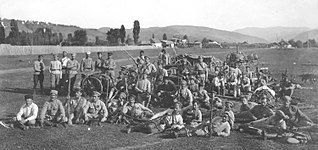
The Sochi conflict was a three-party border conflict which involved the counterrevolutionary White Russian forces, Bolshevik Red Army and the Democratic Republic of Georgia, each of which sought control over the strategic Black Sea town of Sochi. The conflict was fought as a part of the Russian Civil War and lasted with varying success from July 1918 to May 1919, and ended through British mediation.

The ethnic cleansing of Georgians in Abkhazia, also known in Georgia as the genocide of Georgians in Abkhazia, refers to the ethnic cleansing, massacres, and forced mass expulsion of thousands of ethnic Georgians living in Abkhazia during the Georgian-Abkhaz conflict of 1992–1993 and 1998 at the hands of Abkhaz separatists and their allies. Armenians, Greeks, Russians, and opposing Abkhazians were also killed.
The Sukhumi massacre took place on 27 September 1993, during and after the fall of Sukhumi into separatist hands in the course of the War in Abkhazia. It was perpetrated against Georgian civilians of Sukhumi, mainly by militia forces of Abkhaz separatists and North Caucasian allies. It became part of a violent ethnic cleansing campaign carried out by the separatists.
The Government of the Autonomous Republic of Abkhazia is an administration established by Georgia as the legal and only government of Abkhazia. Abkhazia has been de facto independent of Georgia – though with limited international recognition – since the early 1990s. Ruslan Abashidze, elected in May 2019, is the current head of the government-in-exile.

Nestor Apollonovich Lakoba was an Abkhaz communist leader. Lakoba helped establish Bolshevik power in Abkhazia in the aftermath of the Russian Revolution, and served as the head of Abkhazia after its conquest by the Bolshevik Red Army in 1921. While in power, Lakoba saw that Abkhazia was initially given autonomy within the USSR as the Socialist Soviet Republic of Abkhazia. Though nominally a part of the Georgian Soviet Socialist Republic with a special status of "union republic," the Abkhaz SSR was effectively a separate republic, made possible by Lakoba's close relationship with Joseph Stalin. Lakoba successfully opposed the extension of collectivization of Abkhazia, though in return Lakoba was forced to accept a downgrade of Abkhazia's status to that of an autonomous republic within the Georgian SSR.

The Socialist Soviet Republic of Abkhazia was a short-lived republic within the Caucasus region of the Soviet Union that covered the territory of Abkhazia, and existed from 31 March 1921 to 19 February 1931. Formed in the aftermath of the Red Army invasion of Georgia in 1921, it was independent until 16 December 1921 when it agreed to a treaty that united it with the Georgian Soviet Socialist Republic. The SSR Abkhazia was similar to an autonomous Soviet republic, though it retained nominal independence from Georgia and was given certain features only full union republics had, like its own military units. Through its status as a "treaty republic" with Georgia, Abkhazia joined the Transcaucasian Soviet Federative Socialist Republic, which united Armenian, Azerbaijani, and Georgian SSRs into one federal unit when the latter was formed in 1922. The SSR Abkhazia was abolished in 1931 and replaced with the Abkhaz Autonomous Soviet Socialist Republic within the Georgian SSR.
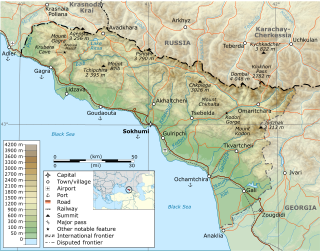
The War in Abkhazia was fought between Georgian government forces for the most part and Abkhaz separatist forces, Russian government armed forces and North Caucasian militants between 1992 and 1993. Ethnic Georgians who lived in Abkhazia fought largely on the side of Georgian government forces. Ethnic Armenians and Russians within Abkhazia's population largely supported the Abkhazians and many fought on their side. The separatists received support from thousands of North Caucasus and Cossack militants and from the Russian Federation forces stationed in and near Abkhazia.
The Battle of Gagra was fought between Georgian forces and the Abkhaz secessionists aided by the Confederation of Mountain Peoples of the Caucasus (CMPC) militants from 1 to 6 October 1992, during the War in Abkhazia. The allies, commanded by the Chechen warlord Shamil Basayev, captured the town of Gagra from the undermanned Georgian forces in a surprise attack, leading to an outbreak of ethnic cleansing of local Georgian population. The battle proved to be one of the bloodiest in the war and is widely considered to be a turning point in the Georgian-Abkhaz conflict. The action, in which Russian commanders were suspected to have aided to the attackers, also resulted in a significant deterioration of the Georgian-Russian relations.

During the Soviet-era, the Abkhaz ASSR was divided into six raions (districts) named after their respective capitals.

The Abkhazian town of Tkvarcheli was put under siege by the Georgian National Guard during the 1992–93 War in Abkhazia. The siege lasted from October 1992 to September 1993, almost the entire duration of the war, but was eventually unsuccessful. It was accompanied by inconclusive fighting in surrounding villages. Russian aid, both humanitarian and military, was critical for the defence of the town which suffered a severe humanitarian crisis during the siege.

Abkhazian railway is a rail operator in the partially recognised state of Abkhazia. Under a monopoly agreement, it is fully managed and partially owned by Russian Railways for a ten year contract from 2009-2019.
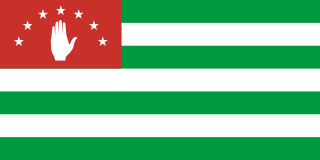
Abkhazia, officially the Republic of Abkhazia, is a partially recognised state in the South Caucasus, on the eastern coast of the Black Sea, at the intersection of Eastern Europe and Western Asia. It covers 8,665 square kilometres (3,346 sq mi) and has a population of around 245,000. Its capital and largest city is Sukhumi.
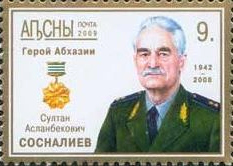
Sultan Aslambekovich Sosnaliyev was a Soviet Army officer of Circassian ethnicity who served as a commander of Abkhaz and North Caucasian forces during the War in Abkhazia and as the defence minister of Abkhazia in 1993–1996 and 2005–2007.
The War in Abkhazia from 1992 to 1993 was waged chiefly between Georgian government forces on one side, Russian military forces on other side supporting separatist forces demanding independence of Abkhazia from Georgia. http://www.historyorb.com/russia/georgia.php Ethnic Georgians, who lived in Abkhazia fought largely on the side of Georgian government forces. Ethnic Armenians and Russians within Abkhazia's population, largely supported Abkhazians and many fought on their side. The separatists were supported by thousands of the North Caucasus and Cossack militants and by the Russian Federation forces stationed in and near Abkhazia.

The People's Guard of Georgia was a Social-Democrat-dominated volunteer force of Georgian former soldiers and civilians, active during the Russian Revolution of 1917 and the Democratic Republic of Georgia from 5 September 1917 to 18 March 1921. It consisted of 2,000 full-time members and 18 field battalions drafted on a territorial basis. In wartime it could mobilize up to 10,000 to 12,000 citizens. The commander of the People's Guard was Valiko Jugheli, and notable members included Kakutsa Cholokashvili, Alexander Koniashvili, Alexander Maisuradze, and Vladimer Goguadze.
Tourism in Abkhazia is possible under Georgian law for foreigners entering the occupied territory from Georgia, although Georgia cannot assure the safety inside disputed territory. However, the Abkazian beaches on the Black Sea continue to be accessible for tourists coming from the Russian side of the Abkhazia–Russia border which is not under Georgian control. Low prices and an absence of any visa requirements attracts Russian tourists especially those who can not afford the vacations in Turkey, Egypt, Bulgaria and other popular Russian touristic directions.

Alexander "Sasha" Berulava was a Georgian journalist, writer, and human rights activist, founder of the Georgian Television of Abkhazia, who was murdered by Abkhaz separatists during the ethnic cleansing of Georgians in Abkhazia in 1993 together with other members of the Government of Abkhazia.
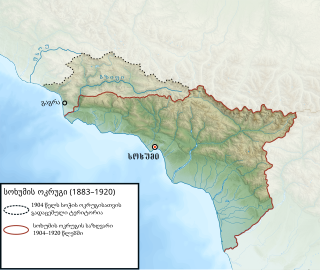
The Abkhazian conflict was an armed conflict in Abkhazia between the Georgian Democratic Republic and Russian Soviet Republic. It consisted of a series of Bolshevik uprisings defeated by the Georgian military.














